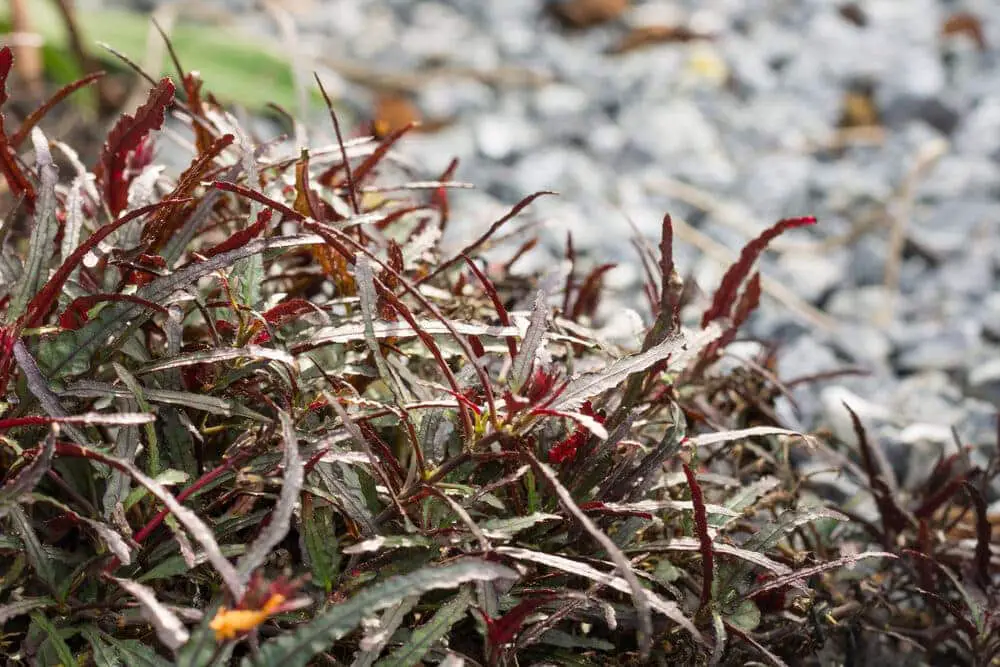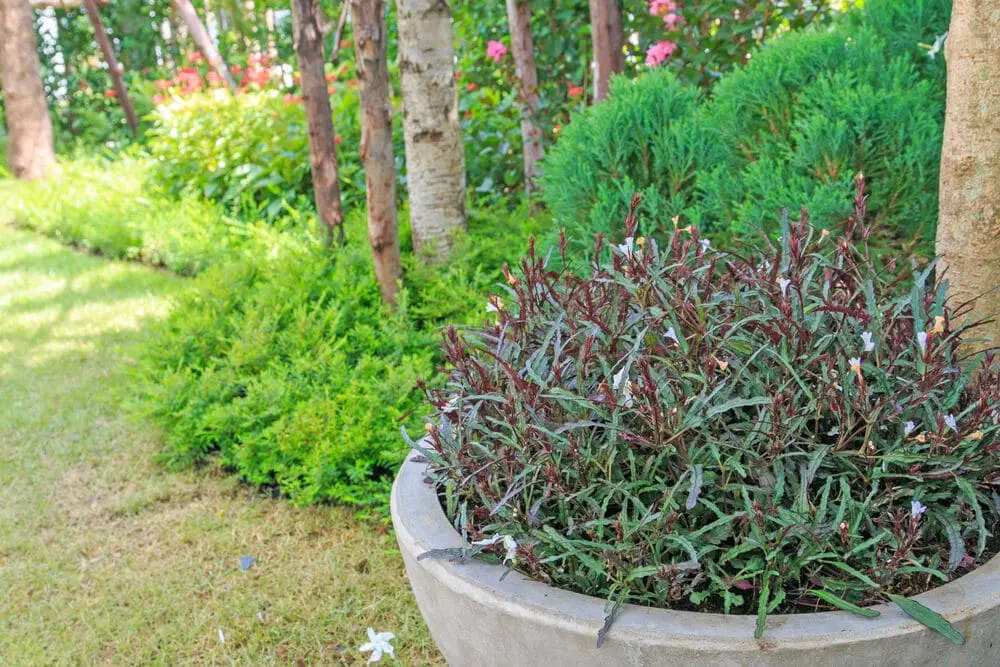The Dragon’s Tongue plant is a gorgeous houseplant, and it makes for an excellent addition to just about any terrarium.
These plants are also easy to grow and take care of. In this article, we will cover everything you need to know about this plant to keep it healthy.
Dragon’s Tongue Plant Care & Growing Guide
1. Light Requirement
It is not a good idea to keep your Dragon’s Tongue plant in direct sunlight, as this can severely damage its foliage. If you put it outside, you’ll want to choose an area around your home that is somewhat shady.
This plant can thrive in low light environments, though it won’t grow as quickly. If you keep it inside your home, you should place it a few feet away from a window with a light curtain. This will ensure that it gets just the right amount of light.
2. Water
You’ll only need to water this plant enough to keep the soil moist but not soaked. The last thing you want is to flood the soil, as it will inevitably lead to root rot.
You will know that it is time to water your Dragon’s Tongue plant when the soil feels dry; all you have to do is touch it to find out. Some of these plants do better when they are a bit drier. You should make a point of checking the instructions for the plant you get.
When you water this plant, make sure that you focus on the root zone exclusively. This is going to be about six to twelve inches from its base. If you are keeping this plant outside, you should consider investing in a soaker hose.
3. Climate
The Dragon’s Tongue plant can be grown in USDA hardiness zones of 11 to 12. They definitely prefer regions with higher temperatures.
4. Soil
You need to put this plant in soil that is moist and drains well. You will have quite a few different soil options to choose from, so you won’t be very limited. You’ll want to avoid soil that compacts easily so you won’t have to deal with root rot.

5. Temperature
The best temperature range for growing and maintaining a Dragon’s Tongue plant is 40 to 60 degrees Fahrenheit. When the weather starts getting any hotter or colder than this, you’ll want to bring the plant inside.
It is always best to provide this plant with a consistently warm environment with a good amount of humidity. This will offer the best chances of maximum growth at a normal rate. A lot of people choose to grow these plants in their greenhouse so they can control the temperature completely.
6. Repotting
When you need to repot your Dragon’s Tongue plant, you’ll need to separate the roots from the rootball. You can do this with a spoon or spatula fairly effectively. If the roots are particularly stubborn, try using a knife with a sharp blade.
Gently slow the plant into its new and slightly larger container. Take a close look at how the roots rest against the bottom of the new pot. You need to make sure that the plant has ample room to grow so you won’t have to do this all over again in another couple of months.
7. Speed of Growth
This plant is a slower grower, so you won’t have to worry about needing to take any action at the drop of a hat. These plants can get fairly large, but it takes a while even under the most ideal conditions. It is a perennial, so you can expect it to live upwards of two years.
8. Height and Spread
You can expect this plant to reach eight inches tall and 12 inches wide. Make sure that you have enough space, as it will likely fan out a decent amount once it is fully matured.

9. Flowers
This plant is known for producing beautiful but very small white flowers.
Is Dragon’s Tongue Plant Poisonous?
There is nothing to indicate that dragon’s tongue is poisonous or toxic to either humans or pets. You can keep this plant in or around your home without having to worry about the safety of your children or any pets you might have.
Can Dragon’s Tongue Plants Grow in Water?
Unfortunately, you will not be able to grow this plant in water. It needs to be kept in moderately moist soil.
Common Dragon’s Tongue Diseases
There are certain insects that these plants are particularly vulnerable to, including whiteflies, bean weevils, and Mexican bean beetles. A good insecticide should really help you with keeping these pests away so your plants stay intact.
These plants can also develop white spots if they are not watered enough. You might also notice the leaves on the plant becoming thinner. Both of these things are major signs that you need to start giving them more water on a regular basis.
Conclusion
- Dragon’s Tongue should never be kept in direct sunlight, as it can do extreme damage to the foliage.
- You’ll want to keep your plant in the shade if it is outside so it stays healthy.
- These plants do best when their soil is kept damp but not soaked.
- If you feel the plant’s soil and it is dry, you’ll want to water it.
- Make sure that the soil you use with this plant is moist and drains very well.
- When repotting this plant, gently separate the roots from the rootball and slide it into a slightly larger container.
- Make sure that the roots have room to spread out in the new pot you put it in.
- This plant does produce flowers that are white and very small.
- There is no information to suggest that any part of this plant is poisonous.
- Insects can be a major problem with these plants, so make sure you have a plan in place to combat them.
Victoria is the owner and main author of hobby plants. She loves spending her free time in her garden planting and taking care of her plants. Victoria hopes you enjoy the content here!
![Mother Of Thousands Plant [Complete Plant Care Guide] Mother Of Thousands Plant [Complete Plant Care Guide]](https://www.hobbyplants.com/wp-content/uploads/2022/07/mother-of-thousands-plant-300x158.jpg)
![Majesty Palm Plant Care: [Complete Beginner's Guide] Majesty Palm Plant Care: [Complete Beginner's Guide]](https://www.hobbyplants.com/wp-content/uploads/2022/08/majesty-palm-care-300x158.jpg)
![Exotic Angel Plant Care: [Complete Beginner's Guide] Exotic Angel Plant Care: [Complete Beginner's Guide]](https://www.hobbyplants.com/wp-content/uploads/2022/08/exotic-angel-plant-care-300x158.jpg)
![Snow White Waffle Plant: [Complete Care Guide] Snow White Waffle Plant: [Complete Care Guide]](https://www.hobbyplants.com/wp-content/uploads/2022/08/snow-white-waffle-plant-300x158.jpg)
![Waffle Plant Care: [Complete Beginner's Guide] Waffle Plant Care: [Complete Beginner's Guide]](https://www.hobbyplants.com/wp-content/uploads/2022/08/waffle-plant-300x158.jpg)
![Bird Of Paradise Plant Care: [Complete Beginner's Guide] Bird Of Paradise Plant Care: [Complete Beginner's Guide]](https://www.hobbyplants.com/wp-content/uploads/2022/08/bird-of-paradise-plant-300x158.jpg)
![Purple Passion Plant Care: [Complete Beginner's Guide] Purple Passion Plant Care: [Complete Beginner's Guide]](https://www.hobbyplants.com/wp-content/uploads/2022/08/purple-passion-plant-care-300x158.jpg)
![China Doll Plant Care: [Complete Beginner's Guide] China Doll Plant Care: [Complete Beginner's Guide]](https://www.hobbyplants.com/wp-content/uploads/2022/09/china-doll-plant-care-300x158.jpg)
![Polka Dot Plant Care: [Complete Beginner's Guide] Polka Dot Plant Care: [Complete Beginner's Guide]](https://www.hobbyplants.com/wp-content/uploads/2022/09/polka-dot-plant-300x158.jpg)
![Mona Lisa Lipstick Plant Care: [Complete Beginner's Guide] Mona Lisa Lipstick Plant Care: [Complete Beginner's Guide]](https://www.hobbyplants.com/wp-content/uploads/2022/09/lipstick-plant-mona-lisa-300x158.jpg)
![Yucca Cane Plant Care: [Complete Beginner's Guide] Yucca Cane Plant Care: [Complete Beginner's Guide]](https://www.hobbyplants.com/wp-content/uploads/2022/09/yucca-cane-plant-care-300x158.jpg)
![Bush On Fire Croton Plant Care: [Complete Beginner's Guide] Bush On Fire Croton Plant Care: [Complete Beginner's Guide]](https://www.hobbyplants.com/wp-content/uploads/2022/09/bush-on-fire-croton-300x158.jpg)